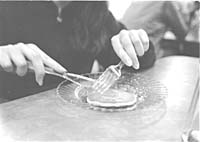

During the past year, Campus Dining Services implemented several changes in the student meal plan, providing formerly disgruntled diners with an array of new options to satisfy their appetites and accommodate their schedules.
Among those changes were the opening of the DeCafé, a convenience store located in the basement of Wilder, the renovation of the Dascomb dining hall and the invention of Flex dollars, a currency that students can use to purchase their meals. Finally, the new system offered students the opportunity to choose between three meal plans, an opportunity that residents of off-campus homes had eagerly demanded during the 1997-98 year.

The new dining options, available to all students who are not members of a co-op, include a plan for 21 meals per week, a plan for 14 weekly meals in addition to 200 Flex dollars per semester and a plan for seven meals and 400 Flex dollars. Meal equivalencies are added to students' identification cards at the beginning of each week, allowing them to eat three meals in any one day, even under the seven-meal plan. And while all three plans cost students a hefty $2978 per year, that sum is over $200 less than the $3192 that students coughed up to eat on-board in past years.
With the Flex dollars available on the 14 and seven-meal plans, students can purchase meals at traditional dining halls like Dascomb and Stevenson, or they can purchase meals and individual items from DeCafé, a convenience store that features a diverse selection of popular products (Ben and Jerry's, Cheerios) and a conventional snack bar. While the Café was originally aimed mostly at upper-class students living off-campus, it has become just as popular an on-campus institution as the old Snack Bar, often attracting scores of students who do not have the time or patience to wait in the lengthy lines that plague Dascomb during the early afternoon lunch hours.
Meanwhile, those who regularly brave the lines at Dascomb have become used to its new look, as certain portions of the old dining hall have been moved in order to create more space for the hundreds of students who descend upon the building each day for a diverse menu that regularly includes pizza, salads, pasta and subs.
According to Assistant Director of Student Life and Services Michele Gross, the purpose of these changes was to "provide a more flexible, diverse meal plan where each student could analyze personal eating patterns to find out what plan matches their needs." Reactions to them, however, have been decidedly mixed.
"Dascomb is really nice, the food is better and there is more space," said junior Keymasha Hall.
Needless to say, other students were not as impressed. "The idea behind DeCafé is a good one, but it could use more variety in its selection," said junior Gardner Swan. "As for Dascomb, it has good pizza, but the rest of it sucks - especially the layout. And the food at Stevenson was as poor as it has always been."
Senior Matthew Badanes expressed similar dissatisfaction with the system. "The food was marginally better, but the meal plan itself was flawed," he said. "Most of the students in past years were upset that they were forced to pay for 21 meals that they did not necessarily need or want. Under the new system, they still pay for 21 meals, only now they have the option of buying food at an overpriced, poorly run snack bar. In the end, it's a bureaucratic solution, not a personal one. Either way, CDS is going to steal your money."
While reactions to the new meal plan have been as diverse as the Dascomb lunch menu, this much is clear: the system has been ushered in smoothly and successfully by the office of Residential Life. "The new multiple meal plan has been well received," said Gross. "Most students seem very happy with the introduction of Flex dollars and the DeCafé market. Now, we plan to hold a survey to see if we need to improve anything or change anything. But, all things considered, people seem happy."
Yeworkwha Belachew, the Interim Associate Dean and Director of Residential Life and Services, agreed with that assessment. "As a result of the new plan, off-board requests have drastically declined," she said. "Students have utilized the system to the fullest. They buy their groceries and their lunches at DeCafé. And they have been responsive to our weekly questions about possible changes, so we've had good feedback. But we're not finished yet. Based on the comment cards and monthly evaluations, we will continue to make changes to satisfy the needs of the students."
So perhaps the new meal plan is not yet perfect, and perhaps it never will be in the eyes of a famously critical student body. Nevertheless, Oberlin students have more meal options today than they ever did before, and, as the office of Residential Life continues to work out the kinks, things can only improve.
Chow Down: Students now have a wide variety of dinning options. (photo by Pauline Shapiro)
Copyright © 1999, The Oberlin Review.
Volume 127, Number 25, May 28, 1999
Contact us with your comments and suggestions.